Birds of Hawaii: Extinct Honeycreepers
Of the 39 “drepanidinines” known to have survived until Europeans reached Hawaii, 22 have gone extinct and a handful more appear poised to join them in oblivion. (For the 17 that survived into the 2020s, see “Birds of Hawaii: the Hawaiian Honeycreepers”.)
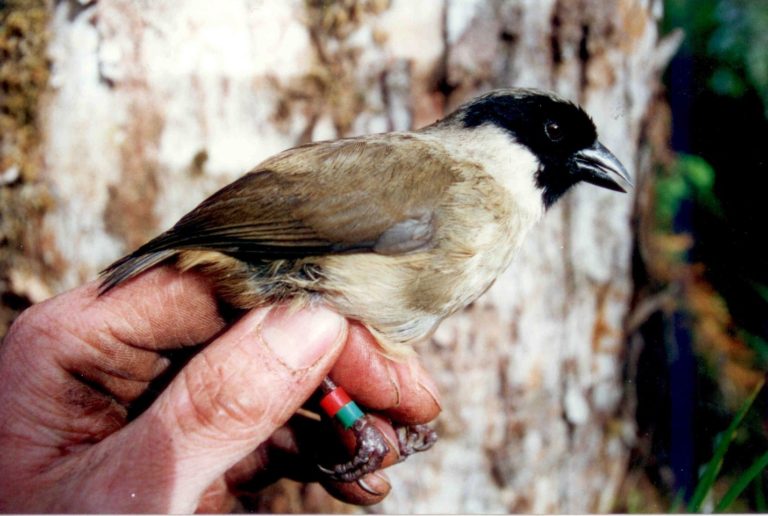
Po’o-uli. (Upper Hanawi Natural Area, Maui, Hawaii; January 15, 1997.) © Paul Baker / HAS Education File
Formerly endemic to Maui.
A stout, aberrant honeycreeper with a deep-based, decurved bill, and a striking midnight-black mask over much of its head, bordered by a gray crown and whitish partial collar. The upperparts were mostly neutral-brown and the underparts were shaded from pale grayish-brown to buffy.
Unknown until 1973, when students from the University of Hawaii discovered a small population in the remote upper Hanawi drainage on the northeastern slopes of Mount Haleakala, where it inhabited the undergrowth of ohia forests between 1,400 and 2,100 m elevation. Fossil evidence shows that it had occupied drier forests at lower elevations, but it had been eliminated from those areas—likely by mosquito-borne malaria as in several other Hawaiian birds with similar extinction stories. After its discovery, the species persisted for about three decades, declining from an initial population estimate of about 750 to 140 in 1980, 80 in 1985, to one, then none, in 2004.
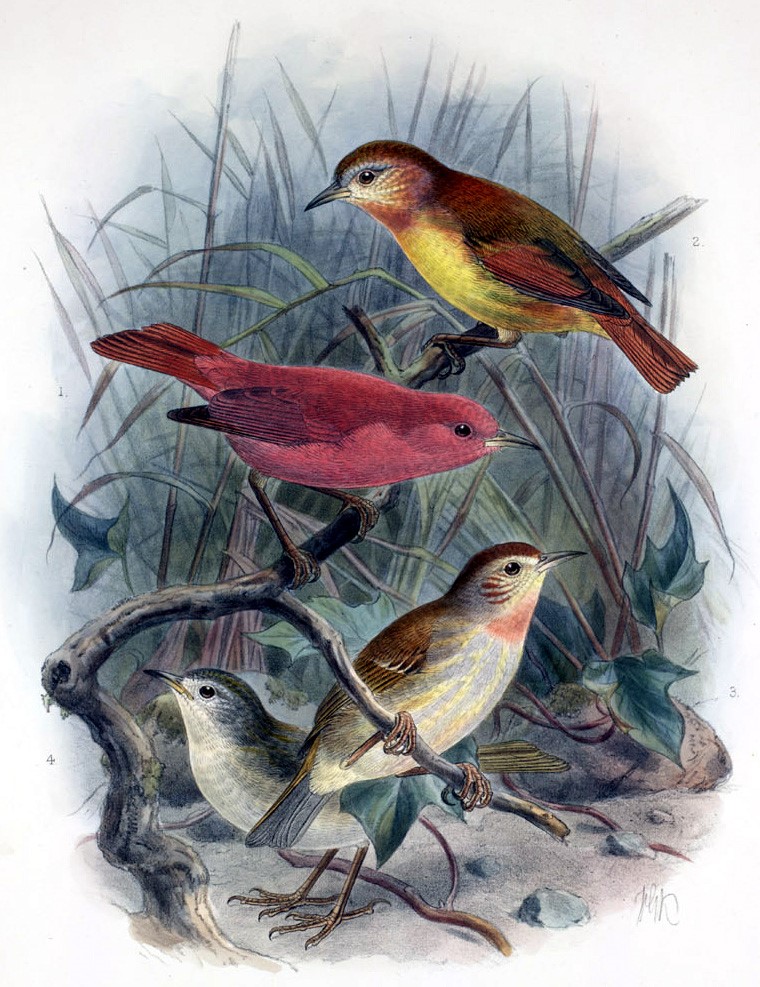
Kakawahie, female, male, immature male, and immature female. John Gerrard Keulemans, 1900
Formerly endemic to Molokai.
A small honeycreeper with a short, slightly decurved, sharp-tipped, brownish-yellow bill. The male was mostly scarlet, and the female was mostly olive-brown with reddish highlights above and yellowish-white below.
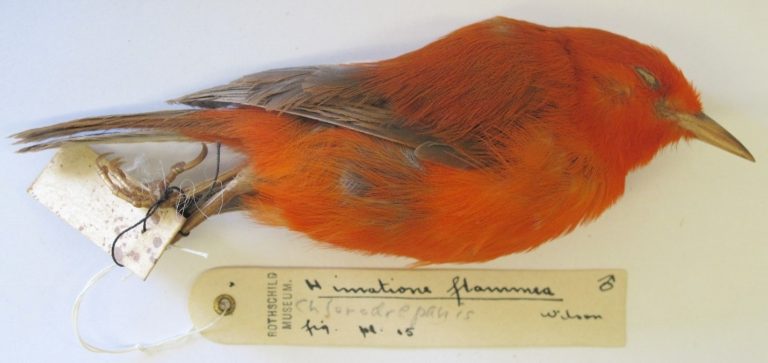
Kakawahie, male. © Andrew Esposito
Last observed in 1963 in the Kamakou Preserve on the Ohialele Plateau. In the the early 1900s it was regarded as common, but by the 1930s it was already rare enough to elude targeted searches for it. A tiny population was rediscovered in 1961, and two pairs and a male were found over the next two years. Organized expeditions to the Molokai highlands in 1975, 1980, 1988, and 2004 found none. Before its decline it was known from all types of wooded habitats from near sea level up to the mountaintops.
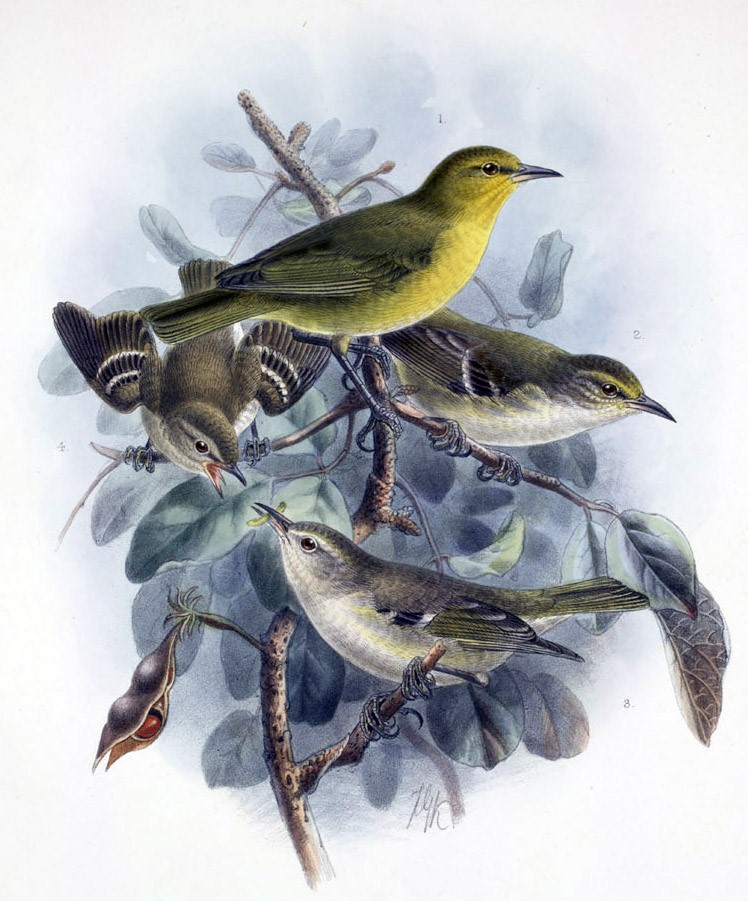
Oahu Alauahio, female, male, and immature male and female. John Gerrard Keulemans, 1900
Formerly endemic to Oahu.
A small honeycreeper with a short, slightly decurved, sharp-tipped bill. The male was mostly bright-yellow below and on the face, with olive-brown upperparts, dark lores, and a broad yellow forehead and eyebrow. Females were plain, mostly olive and whitish with wingbars.
Known mainly from wet foothill forests. The last incontrovertible record was a specimen collected on September 19, 1968, along the Poamoho Trail in north-central Oahu. The last sighting that is generally credited as reliable was along the same trail on December 12, 1985. There were many sight records in the late 1900s (at least 30 between 1968 and 2002), some of which included persuasive details and may have been accurate, which leaves some room for hope that it may yet survive to be rediscovered.
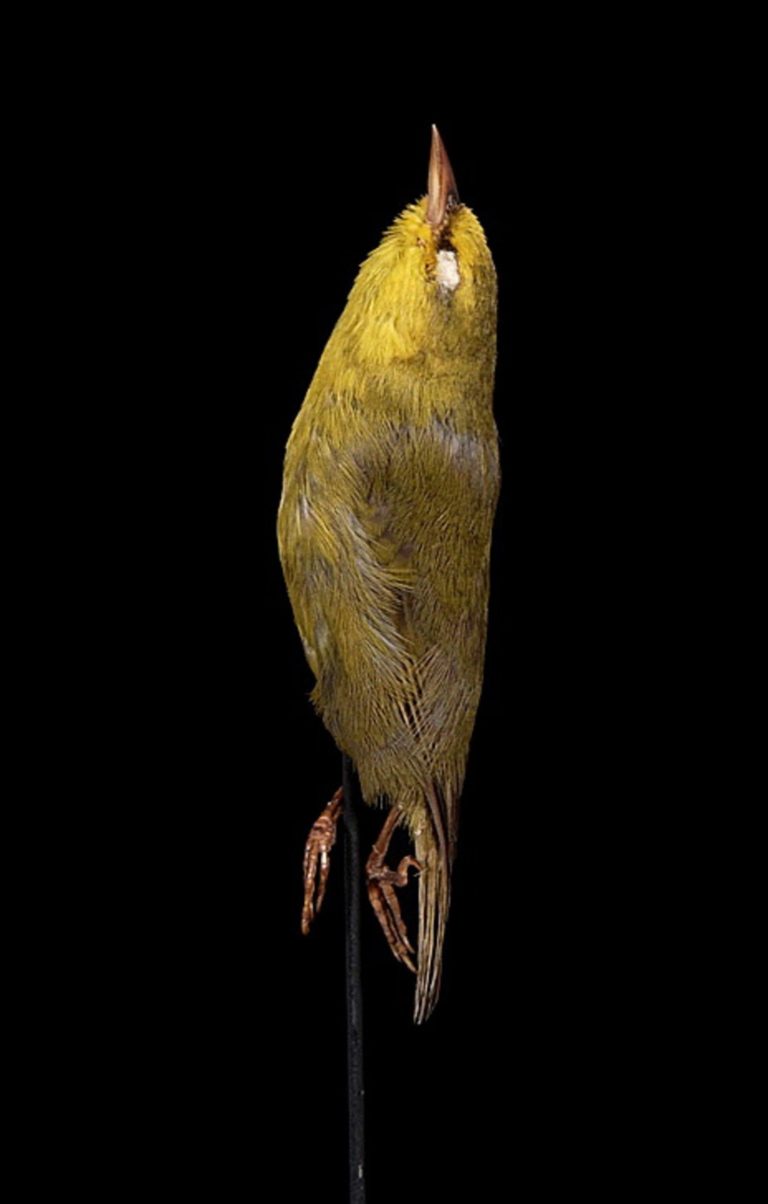
Oahu Alauahio, male. (Waimamae, Oahu, Hawaii; February 23, 1901.) © Naturalis Biodiversity Center
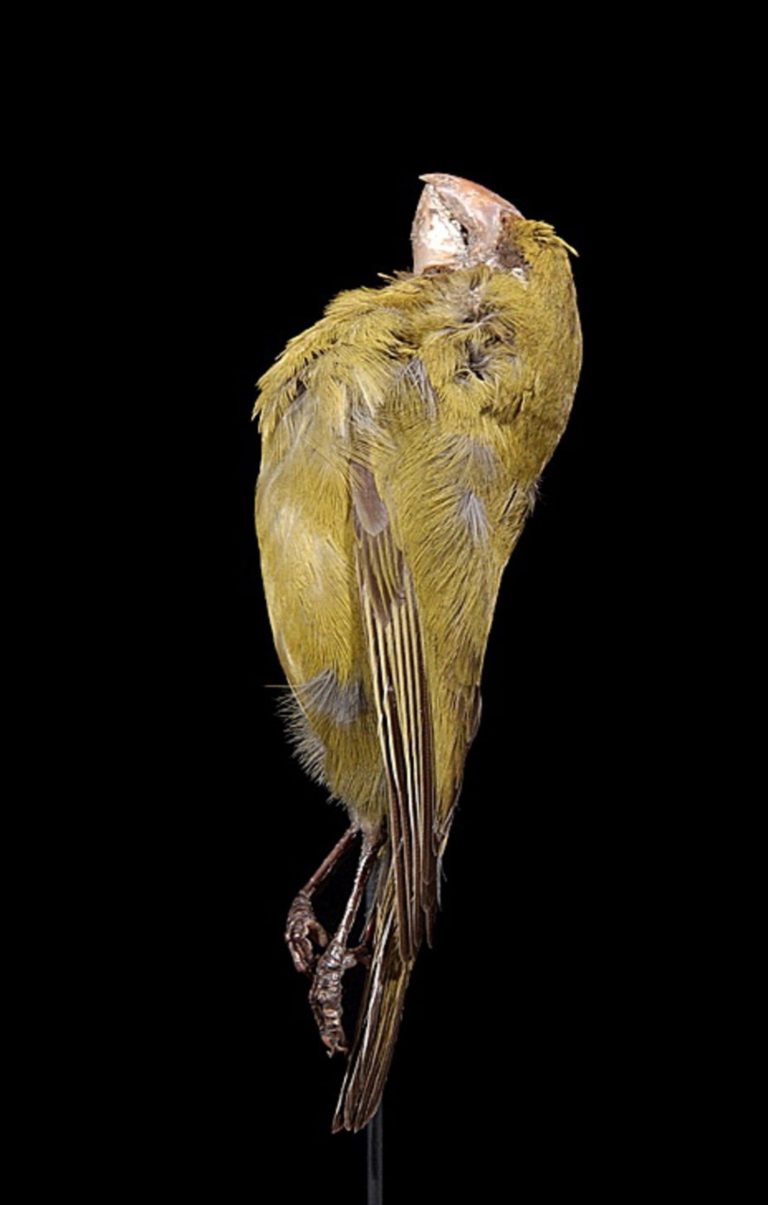
Kona Grosbeak, male, side view. (Kona, Big Island, Hawaii; October 15, 1891.) © Naturalis Biodiversity Center
Formerly endemic to the Big Island.
A medium-sized, stocky, olive grosbeak with a massive pink bill.
Known from forests between approximately 1,400 and 1,700 m elevation on the slopes of Pu’u Hualalai and Mauna Loa, where it was mostly observed feeding on naio and māmane fruits. The last confirmed observation was the collection of a set of specimens in September 1892 on the northwestern slopes of Mauna Loa barely five years after the collection of the type specimen on June 21, 1887. All recorded observations of the species occurred at middle elevations on the west side of the Big Island on Mauna Loa and Hualalai.
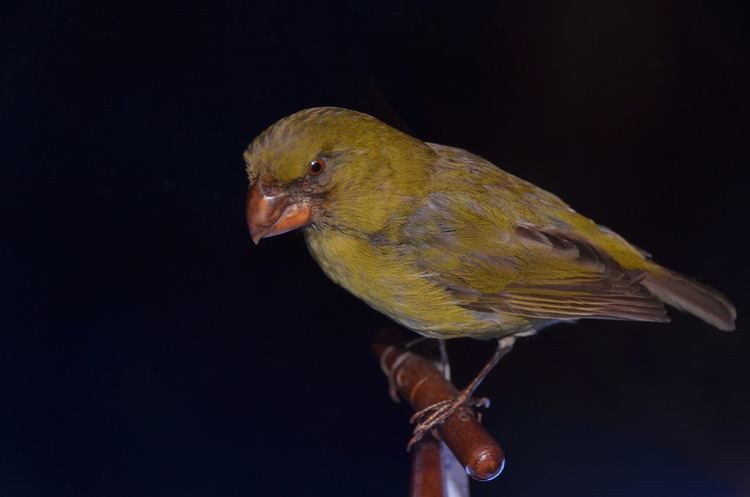
Kona Grosbeak. © Bernice Pauahi Bishop Museum

Kona Grosbeak, close-up view of its massive bill. © Bernice Pauahi Bishop Museum
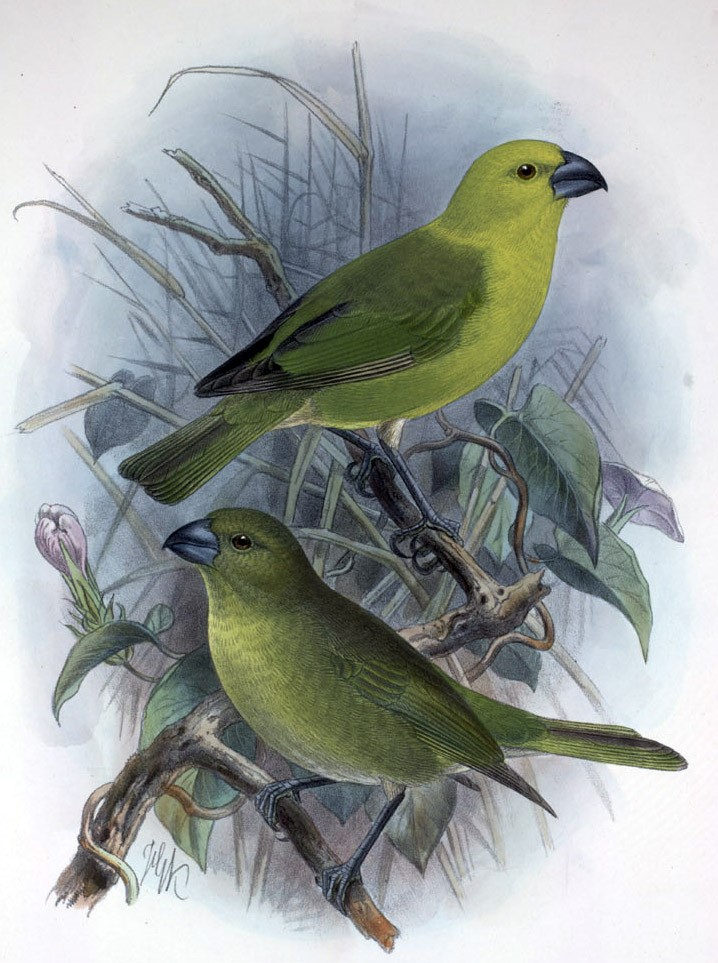
Lesser Koa-Finch, male and female. John Gerrard Keulemans, 1900
Formerly endemic to the Big Island.
A medium-large olive grosbeak. Male had dark-olive upperparts, a yellow head and breast, and yellowish-olive belly. Females and immatures were dark-olive above, with paler yellowish and grayish tones in their underparts. They were easily confused with the Greater Koa-Finch—and were initially thought to belong to that species.
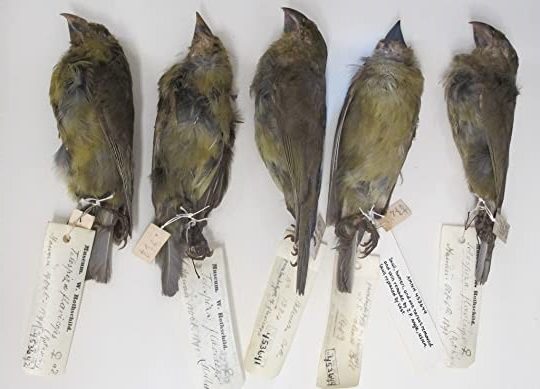
Lesser Koa-Finch, females. © Andrew Esposito
Found only on one occasion, during a collecting expedition from September 30 to October 16, 1891, when eight specimens were collected at Pu’u Lehua Ranch on Pu’u Hualalai, between approximately 1,400 and 1,500 m elevation. The collectors believed that they were females or immatures of a closely related species that was present in larger numbers, the Greater Koa-Finch, of which sixteen specimens were collected together with the Lessers during the same expedition. As its name suggests, it was associated with the koa tree (Acacia koa) and is believed to have subsisted largely on the koa seed.
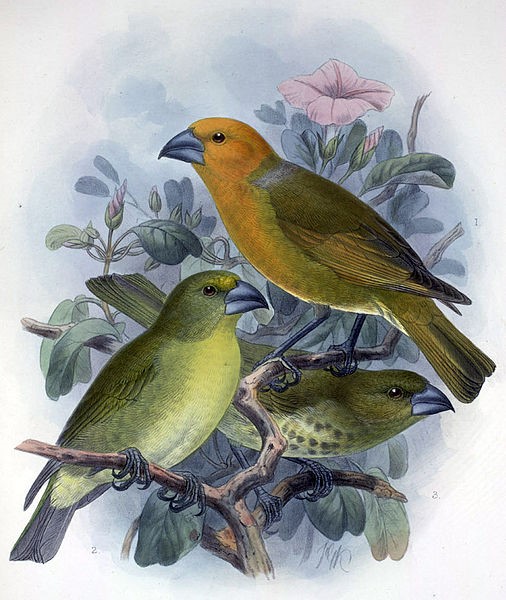
Greater Koa-Finch, male, female, and immature. John Gerrard Keulemans, 1900
Formerly endemic to the Big Island.
A large grosbeak, the largest native Hawaiian songbird that survived long enough to be scientifically described. Male was reddish overall, brighter and more orange-toned on the head, underparts, and rump, duller and more olive-toned on the rest of the upperparts. Females and immatures were olive overall, dark and greenish above, with pale yellowish or grayish underparts. They were easily confused with its sibling species, the Lesser Koa-Finch—which was initially thought to be the female Greater Koa-Finch.
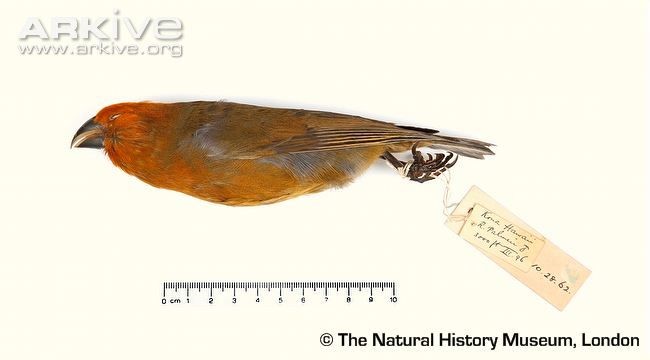
Greater Koa-Finch, male. © The Natural History Museum, London
Known from koa forests between approximately 900 and 1,900 m elevation, mostly on the slopes of Pu’u Hualalai, but also on southern and eastern slopes of Mauna Kea. As its name suggests, it was strongly associated with the koa tree (Acacia koa) and subsisted largely on the koa seed.
All documented observations occurred between September 1891 and March 1896 in a few remnants of previously widespread koa forest, where it was locally common, then vanished. Many of the later-collected specimens reportedly had swollen feet and missing toes or claws, which seems to indicate that a particular disease spread rapidly through the remaining population and extinguished it.
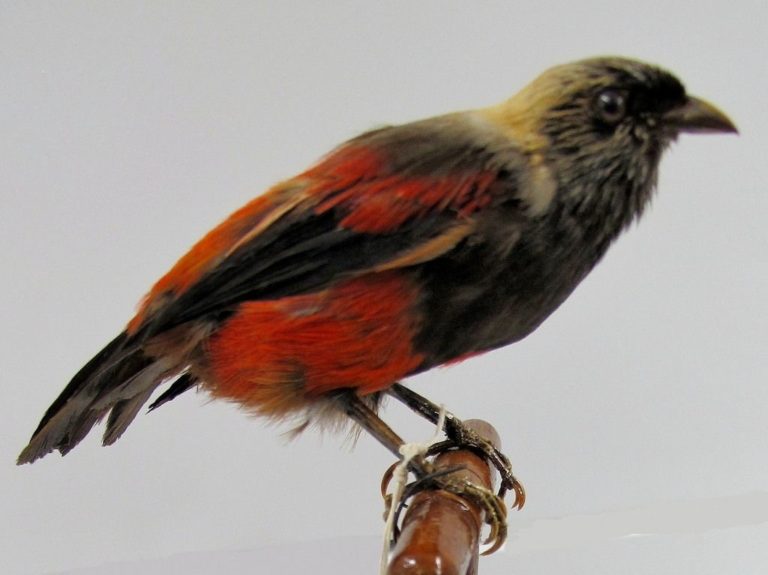
Ula-ai-hawane, male. © Bernice Pauahi Bishop Museum
Formerly endemic to the Big Island.
A small honeycreeper with a tanager-type bill. Male plumage was striking and distinctive: red belly, back, rump, and shoulders, black head, breast, wings, and tail, gray mantle, and streaked face and breast. The female was olive.
Known mainly from five specimens taken between 1859 and 1892. The locations were not well-documented, but were reputed to be from the northern portion of the Big Island—with at least two from the hills above Hilo and another from the Kohala Mountains—where they were associated with groves of Pritchardia palms, which produce the “hawane” fruit for which the bird is named.
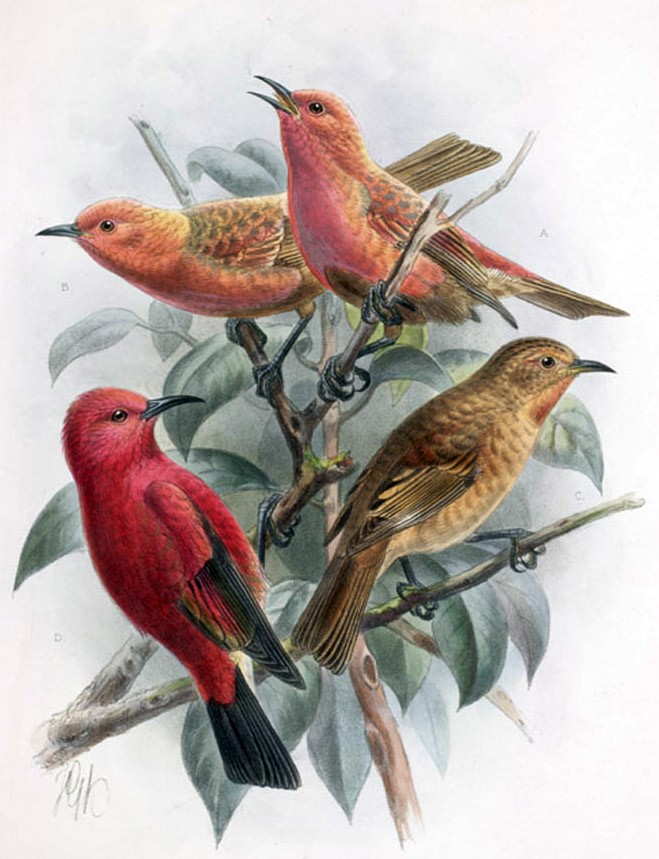
Laysan Honeycreeper, two adults above, with an immature in the lower right and an Apapane in the lower left. John Gerrard Keulemans, 1890
Formerly endemic to Laysan Island.
A mid-sized honeycreeper with a thin, decurved, black bill, and mostly red plumage, mottled with sooty blackish-gray. The wings, tail, lower belly, and undertail coverts were sooty. A washed out version of its close relative, the Apapane.
Remained common into the 1910s: the population was estimated at 1,000 in 1915. But European Hare introduced in 1903 eventually denuded Laysan of most of its vegetation, leaving little habitat for landbirds. By April 1923, three honeycreepers remained, and a major storm delivered the coup de grâce.

Laysan Honeycreeper. (Specimen on display at Bernice Pauahi Bishop Museum.) © David Eickhoff

Black Mamo. John Gerrard Keulemans, 1900
Formerly endemic to Molokai.
A large black honeycreeper with an enormously long, sickle-shaped bill, and white primaries.
The last documented observation was a specimen collected on June 7, 1907, at the heads of the Moanui and Waialua valleys in eastern Molokai. The species had been first collected fourteen years earlier, on June 18, 1893, and was always considered uncommon and confined to the cloud forests of Molokai. Fossilized remains have also been discovered on Maui.
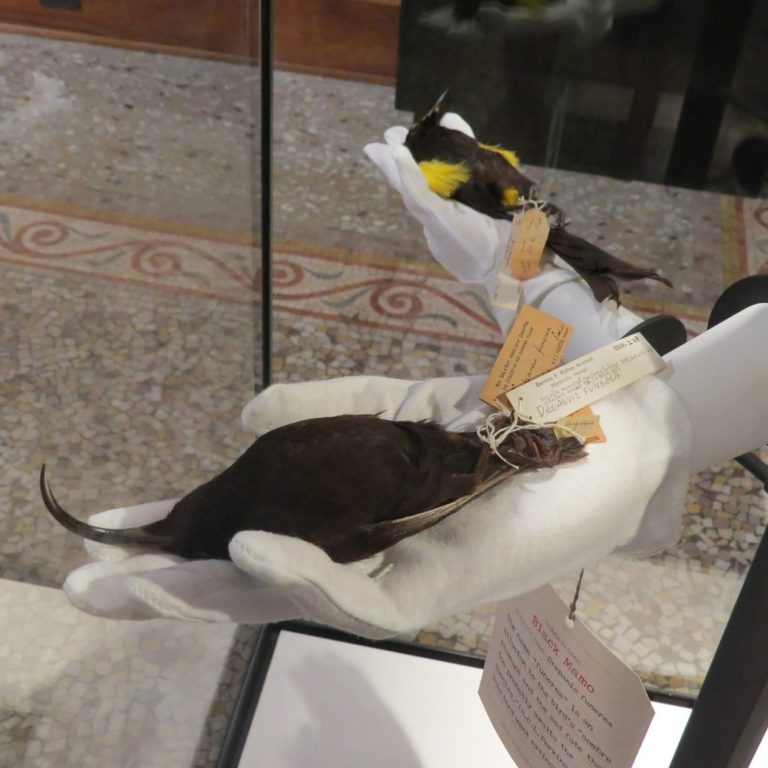
Black Mamo, foreground. (Specimen on display at Bernice Pauahi Bishop Museum.) © David Eickhoff
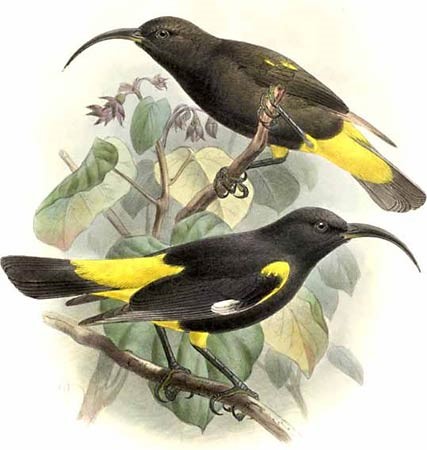
Hawaii Mamo. John Gerrard Keulemans, 1900
Formerly endemic to the Big Island.
A very large black honeycreeper with a long, decurved bill, yellow shoulders, rump, and vent, and a white spot or stripe at the base of the primaries.
The last documented observation occurred near Ka’umana in July 1898. The species had been uncommon in lowland and foothill forests of the Big Island throughout most of the 1800s. Only a few specimens were collected in part because it was rarely encountered and in part because it had a partially protected status—its feathers were reserved for adornments of royalty such as the “million dollar cloak” of King Kamehameha I (held by the Bernice Pauahi Bishop Museum) which includes an estimated 450,000 feathers from an estimated 80,000 Hawaii Mamos.

Hawaii Mamo. © Naturalis Biodiversity Center

O’u, male. (Sincock’s Camp, Alaka’i Wilderness Preserve, Kauai, Hawaii; June 6, 1975.) © Mike Scott
Formerly endemic to Hawaii’s main islands.
A large, proportionately heavy-bodied honeycreeper with a pinkish, parrotlike bill. Male had deep-olive upperparts, lead-gray underparts with yellowish highlights, and a bright-yellow head. Females and immatures were olive and gray.
The last certain observation was on February 17, 1989, in the Alakai Swamp of Kauai. The last certain observation on the Big Island was of two seen together in the Ola’a Tract on June 14, 1986.

O’u, male. (Kaleakekua Bay, Big Island, Hawaii; January 18, 1779.) © Naturalis Biodiversity Center
During the 1800s it was abundant on the six largest islands, but toward the end of that century it declined rapidly on most islands, and disappeared from Oahu around 1900, Maui and Molokai around 1910, and Lanai around 1930. Populations in the dozens or low hundreds persisted in Kauai’s highlands and the eastern side of the Big Island into the late 1970s, then dwindled rapidly in the 1980s.
It is thought to have been somewhat nomadic in search of fruiting trees, and sometimes wandered from island to island. Its most favored habitat was likely ohia-dominated forest at elevations of about 300 to 1,200 m, but it occurred across a broad set of habitats from sea level to at least 2,100 m. Avian malaria appears to be the primary cause of its extinction, and the species’ proclivity for descending to lowlands probably ensured that no portion of the population avoided contact with malarial mosquitoes.
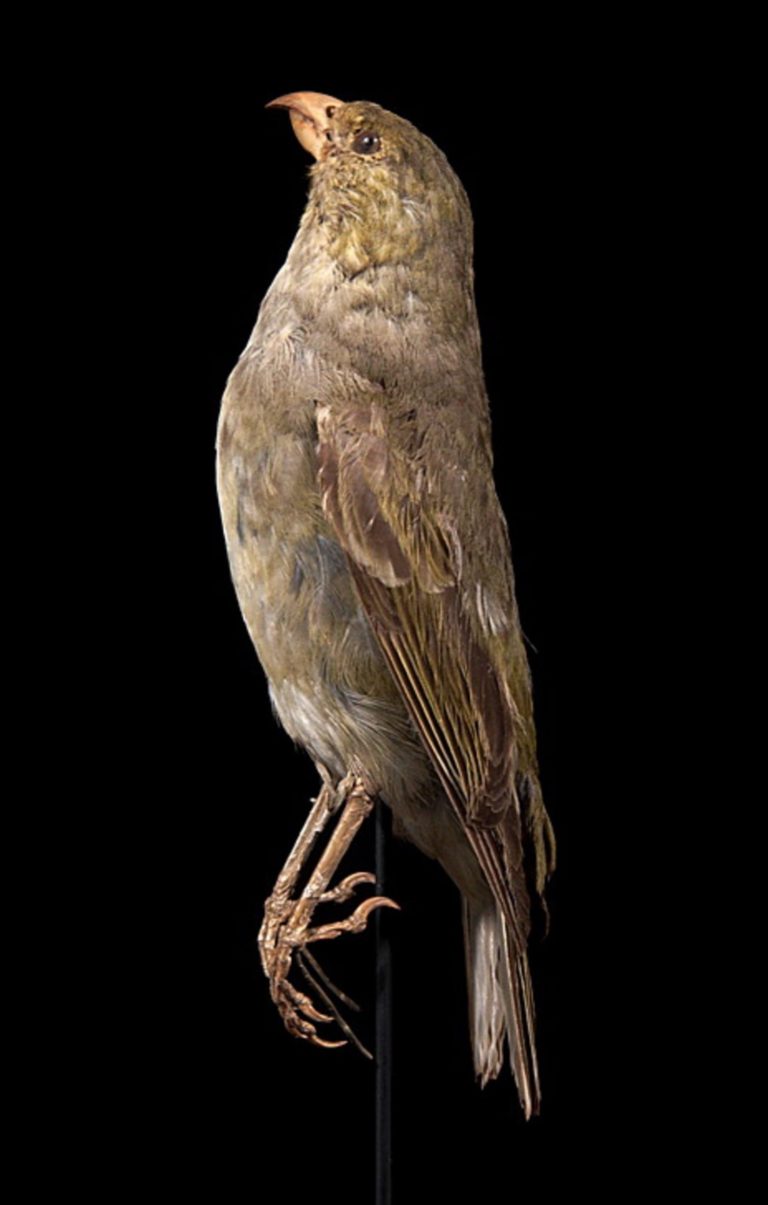
O’u, female. © Naturalis Biodiversity Center
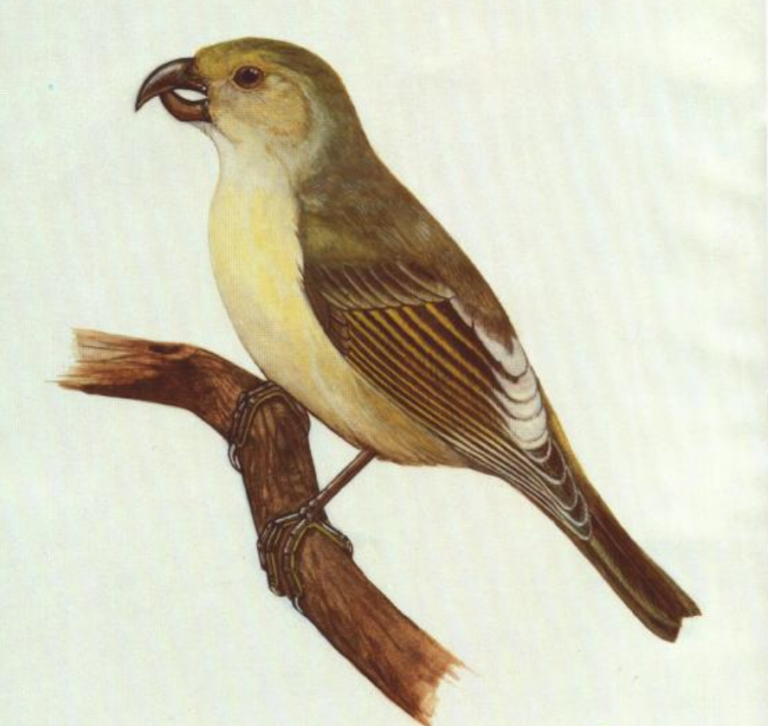
Painting of Lanai Hoookbill. © Nancy Payzant
Formerly endemic to Lanai.
A stocky honeycreeper with a peculiarly formed, reddish-brown bill, apparently adapted to a diet of tree-snails. Both mandibles were strongly curved toward each other, as in a pair of forceps, but the upper was somewhat longer than the lower. The typical plumages are not fully known. The only specimen, thought to be a female, was mostly olive above, and mottled with yellow, white, and gray below.
Known only from the field observations and collecting gun of George Munro, who observed it in 1913, 1916, and 1918 in the Kaiholena Valley of Lanai. He collected the only described specimen on February 22, 1913, and reported details of nonlethal encounters on March 17, 1916, and August 12, 1918. All observations of the species were in dry foothill forests that were remnants of extensive lowland forests that had been replaced by pineapple plantations.
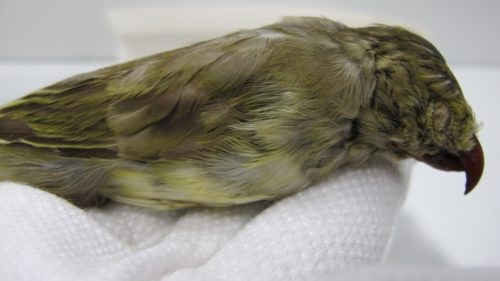
Lanai Hookbill. (The type specimen, collected February 22, 1913.) © Andrew Esposito
During most of the 1900s, the validity of the species was contested, as the prevailing authorities concluded that the sole specimen was actually an O’u with a deformed bill, until a 1989 article argued convincingly that it was a valid species—which Munro’s detailed observations had quite clearly established decades earlier, if they had been taken seriously.
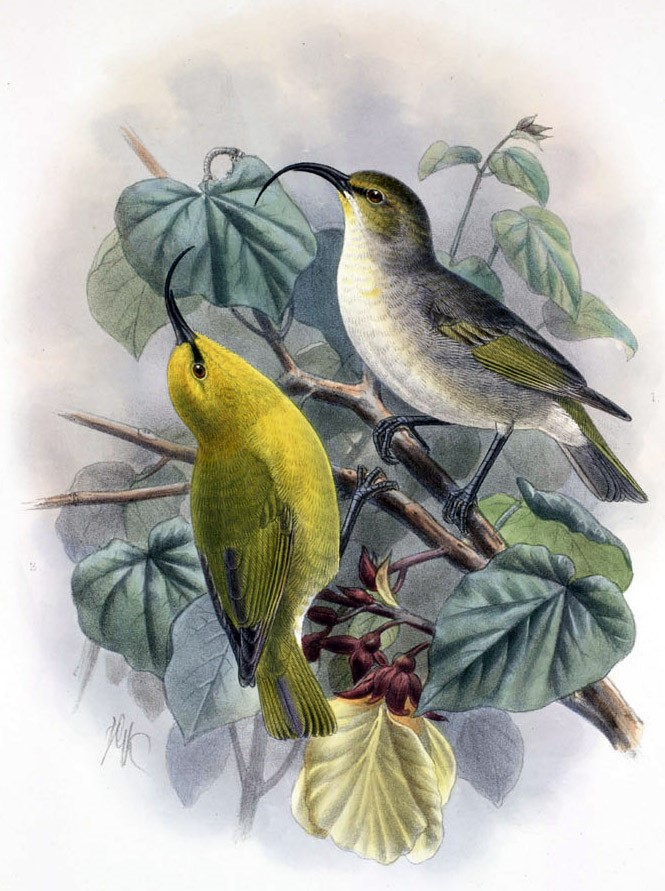
Kauai Nukupu’u, adult and immature males. John Gerrard Keulemans, 1900
Formerly endemic to Kauai.
A stout, short-tailed honeycreeper with a long, decurved bill, the upper mandible about twice as long as the lower. The male was mostly bright-yellow with olive upperparts, white undertail coverts, and a strongly defined black mask that merged into the black bill. Females and immatures were mostly olive-gray above and whitish below, with yellowish highlights in the face, wings, and tail.
Traditionally considered conspecific with Oahu and Maui Nukupu’us, known collectively as the Nukupu’u (Hemignathus lucidus). Kauai’s was more sexually dimorphic than the others: the male was the yellowest and the female was the grayest.
Known mainly from wet forests of west-central Kauai at elevations of around 600 to 1,200 m. The last incontrovertible record was the collection of two specimens at Makaweli on May 6, 1899. There were few if any reports during the next six decades, until a sighting of two together in the Alakai Swamp on August 16, 1960.
Over the next four decades, at least 25 more sightings there followed, none supported by physical evidence, but some with multiple signatories and persuasive details. The most recent sighting deemed credible enough for the IUCN to mention was reported in 2007. A significant problem with the many modern nukupu’u sightings on Kauai and Maui is the occasional appearance of an amakihi with a deformed bill.
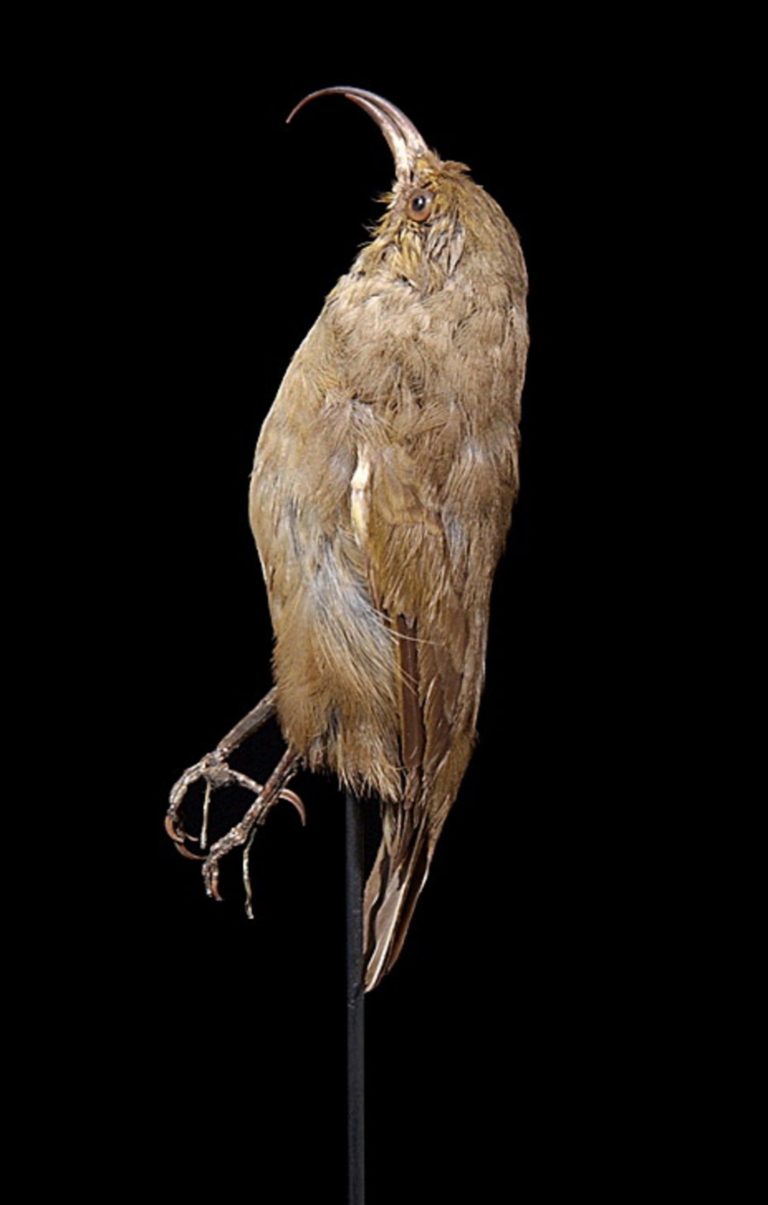
Oahu Nukupu’u, male. © Naturalis Biodiversity Center
Formerly endemic to Oahu.
A stout, short-tailed honeycreeper with a long, decurved bill, the upper mandible about twice as long as the lower. The male had mostly olive upperparts, including the crown, and mostly yellow underparts, including the face. Females and immatures were duller olive above and whiter below than the male.
Formerly considered conspecific with Kauai and Maui Nukupu’us, known collectively as the Nukupu’u (Hemignathus lucidus). Oahu’s had a slightly longer bill than the others, and the male had duller, olive not yellow plumage.
Known mainly from a set of specimens collected in the Nu’uanu Valley from January 11 to 15, 1837. Two additional specimens were collected between 1838 and 1841, and residents of the area reported that the species continued to be seen there until around 1860.
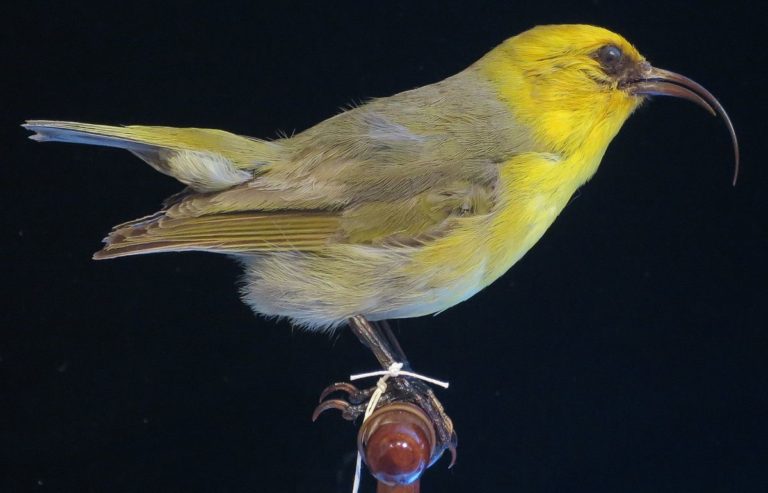
Maui Nukupu’u, male. © Bernice Pauahi Bishop Museum
Formerly endemic to Maui.
A stout, short-tailed honeycreeper with a long, decurved bill, the upper mandible about twice as long as the lower. The male had an essentially all-yellow head, an olive back, and a strongly defined black mask that merged into the black bill. Females and immatures had a mostly olive head and neck with yellow on the face and throat.
Formerly considered conspecific with Kauai and Oahu Nukupu’us, known collectively as the Nukupu’u (Hemignathus lucidus). Maui’s had intermediate plumage: the male resembled males from Kauai while the females resembled males from Oahu.
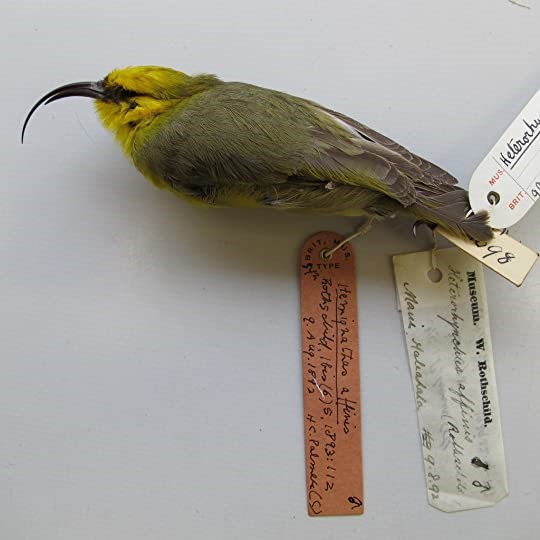
Maui Nukupu’u, male. (Haleakala, Maui; August 9, 1892.) © Andrew Esposito
Known mainly from montane ohia forests on the northern slopes of Mount Haleakala at elevations of around 1,200 to 2,150 m. In the 1800s, it was most often observed and collected above Olinda (in or near the current Waikamoi Preserve). The last record that is generally accepted as valid occurred in June 1901, and with few if any reports for over 60 years the U.S. Fish & Wildlife Service declared it extinct in 1966.
From 1967 to 1998 many observers reported sightings, mainly from the remote Hanawi Natural Area Reserve. None were supported by physical evidence, but some had multiple signatories and persuasive details. The last of these was in 1995. A significant problem with the many modern nukupu’u sightings on Kauai and Maui is the occasional appearance of an amakihi with a deformed bill.
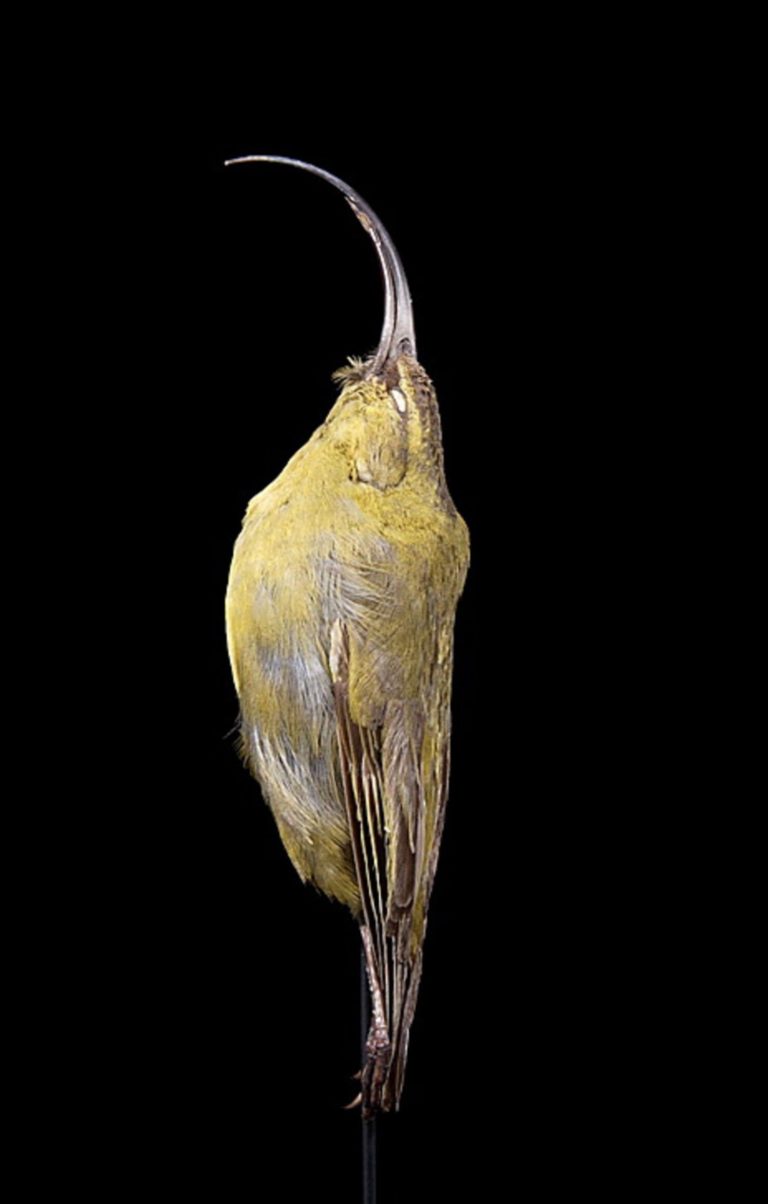
Kauai Akialoa, female. (Kahaluamano, Kauai; October 1895.) © Naturalis Biodiversity Center
Formerly endemic to Kauai.
A very large honeycreeper with an extraordinarily long, scimitar-shaped bill gray, bright-olive upperparts, and yellow underparts. The male was more brightly colored than the female and had a more strongly curved bill, while the female’s bill was longer—the longest bill among all the honeycreepers known to science. Immatures were duller than adults, mostly gray above and whitish below, and had two prominent whitish wingbars. Traditionally considered conspecific with Oahu, Maui Nui, and Lesser Akialoas, known collectively as the Akialoa (Hemignathus ellisianus).
Known from ohia forests throughout Kauai at elevations of around 200 to 1,300 m. It was regarded as common across much of Kauai in the 1800s, but dwindled rapidly toward the end of that century, and many of the specimens taken in the 1890s had conspicuous lesions and tumors, apparently indicating that the species as a whole was succumbing to disease. By 1920 it had vanished from most of its range and was suspected to be extinct until 1960 when a small population was rediscovered in the Alakai Swamp. The last observation that is widely regarded as reliable was along the Pihea Trail at the northern end of the Alakai Swamp on April 12, 1969.

Oahu Akialoa. © John Gerrard Keulemans, 1900
Formerly endemic to Oahu.
A very large honeycreeper with an extraordinarily long, scimitar-shaped bill gray, olive upperparts, yellow breast, white belly, and yellow highlights in the wings and tail. Although very long, its bill was somewhat shorter than that of the Kauai Akialoa. Traditionally considered conspecific with Kauai, Maui Nui, and Lesser Akialoas, known collectively as the Akialoa (Hemignathus ellisianus).
Known mainly from three specimens collected in the Nu’uanu Vally from January 11 to 15, 1837. The last universally accepted record was of a pair at Nu’uanu in October 1892. There was a spate of reported observations in the late 1930s, the last on February 19, 1939 at Makakilo, but modern reviewers have questioned their reliability.

Maui Nui Akialoa, male. © Paul Sweet
Formerly endemic to Lanai.
A very large honeycreeper with an extraordinarily long, scimitar-shaped bill. The male was golden-olive above and yellowish below. Females and immatures were dull-olive above and whitish below. Traditionally considered conspecific with Kauai, Oahu, and Lesser Akialoas, known collectively as the Akialoa (Hemignathus ellisianus).
Known mainly from three specimens collected above Ko’ele from November 15 to 22, 1892. The last universally accepted record was of a male in approximately the same location on January 9, 1894. There were additional sightings at Lana’ihale during November 1892 and another credible, but uncertain sighting of a male sometime between 1911 and 1930. Subfossil remains have been discovered on Molokai—and thus known to have been present on Maui Nui (i.e., “Greater Maui,” which includes Lanai and Molokai), hence its name.
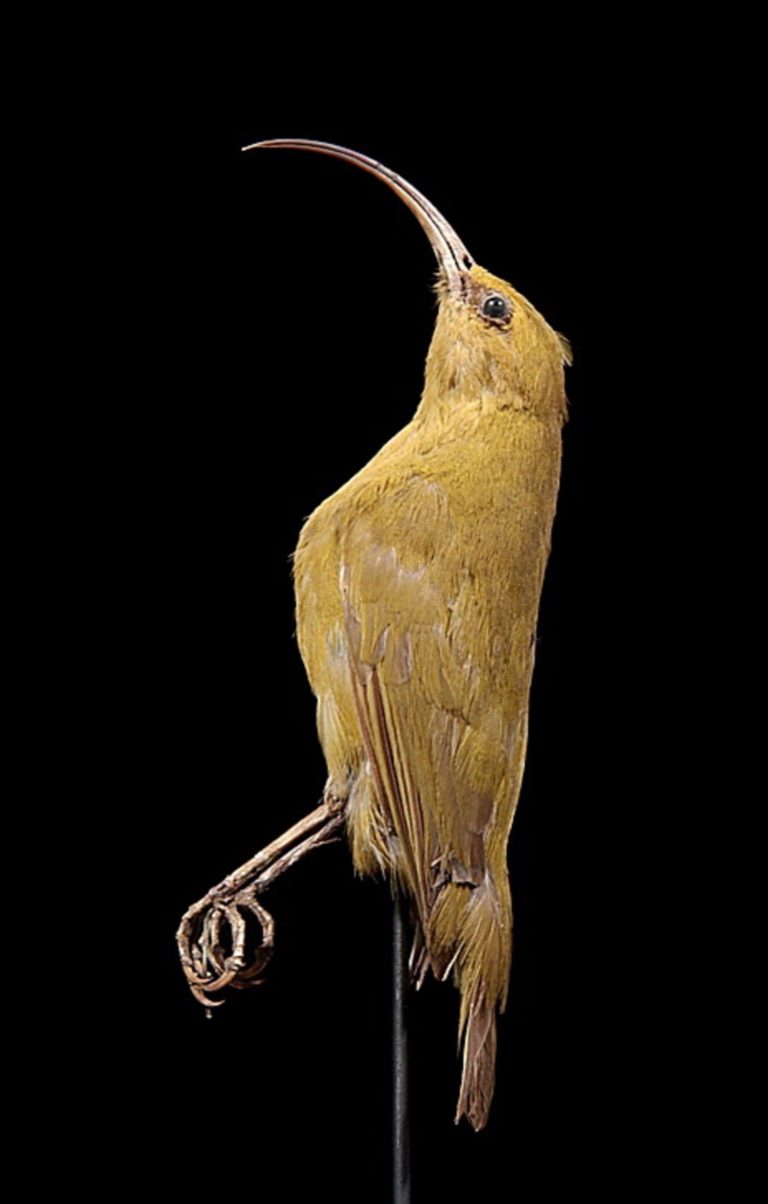
Lesser Akialoa. © Naturalis Biodiversity Center
Formerly endemic to the Big Island.
A medium-large honeycreeper with a long, scimitar-shaped bill, bright-olive upperparts, and yellow underparts. The female was duller overall than the male. Immatures were somewhat duller still, brownish-olive above and yellowish-white below. Traditionally considered conspecific with Kauai, Oahu, and Maui Nui Akialoas, known collectively as the Akialoa (Hemignathus ellisianus). Somewhat smaller than the other akialoas, Lesser’s bill was the shortest relative to its body size and the most strongly decurved.
Known from foothills forests throughout the Big Island, mainly at elevations between around 350 and 800 m, but reportedly occurred at least occasionally up to around 2,000 m. The last incontrovertible record was the collection of two specimens at Umikoa, north of Mauna Kea, in September 1903.
It was regarded as common well into the 1890s, but vanished extremely quickly around the turn of the century. There were isolated reports in 1937 and 1940 from Keanakolu, on the northeastern slope of Mauna Kea, also near Umikoa. The 1937 report was of a vocalization identified as an akialoa based on its similarity to the voice of the Kauai Akialoa, and the 1940 report was visual, but these reports seem inherently dubious coming so long after the sudden islandwide collapse.

Greater Amakihi. © Bernice Pauahi Bishop Museum
Formerly endemic to the Big Island.
A medium-sized honeycreeper with a thin, slightly decurved, sharp-tipped bill, like that of an oriole. All plumages were predominantly dull-olive above and yellowish below, brightest on the face, throat, and chest.
Known from wet lowland and foothill ohia forests between around 150 and 1,200 m elevation. Apparently, all documented records were from the Wailuku River Valley west of Hilo. It was first collected on April 23, 1892 and last recorded in 1901 or 1902. During that decade of known existence it was apparently locally common, with up to twelve being seen in a day of field work, and at least 32 specimens collected overall.
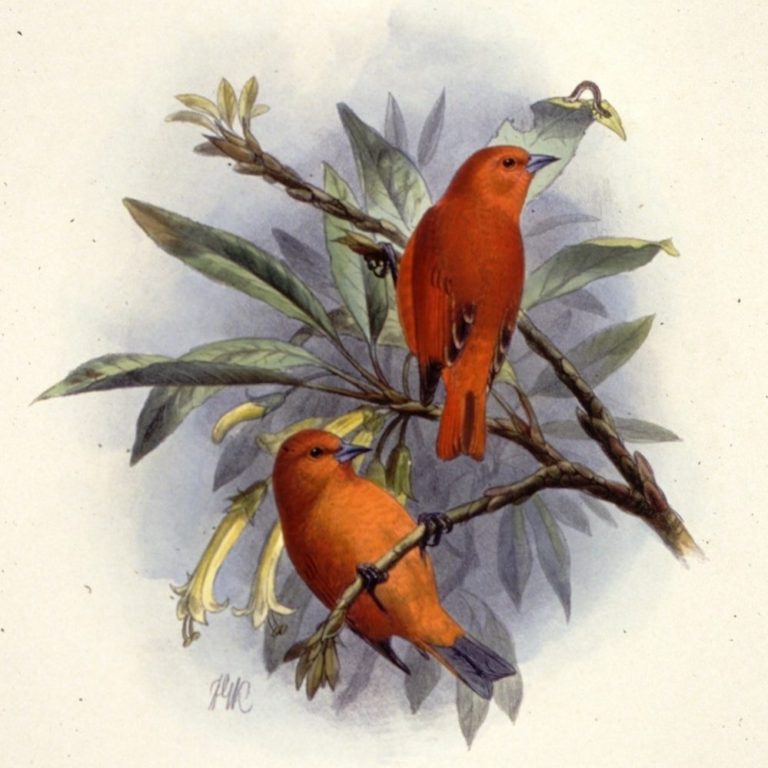
Oahu Akepa, males. © John Gerrard Keulemans 1900
Formerly endemic to Oahu.
A small honeycreeper with a short, thin bill. Similar to Hawaii Akepa but the bill was gray, the male plumage was more rufous-orange above and paler reddish-orange below, and female was darker olive-gray. Traditionally considered conspecific with Maui and Hawaii Akepas, known collectively as the Akepa (Loxops coccineus).
The last observation that is generally accepted as reliable was in 1900 or 1901 in Wahiawa. E. Wolstenholme collected the last specimen on April 24, 1893. It remained common in mountain forests of Oahu through the mid-1800s (e.g., in 1837 many were collected in the Nu’uanu Valley) but declined rapidly toward the end of the century. The most recent reported observation was in December 1976 near the summit of the Schofield-Waikane Trail above Wahiawa, but this seems unlikely to be correct.
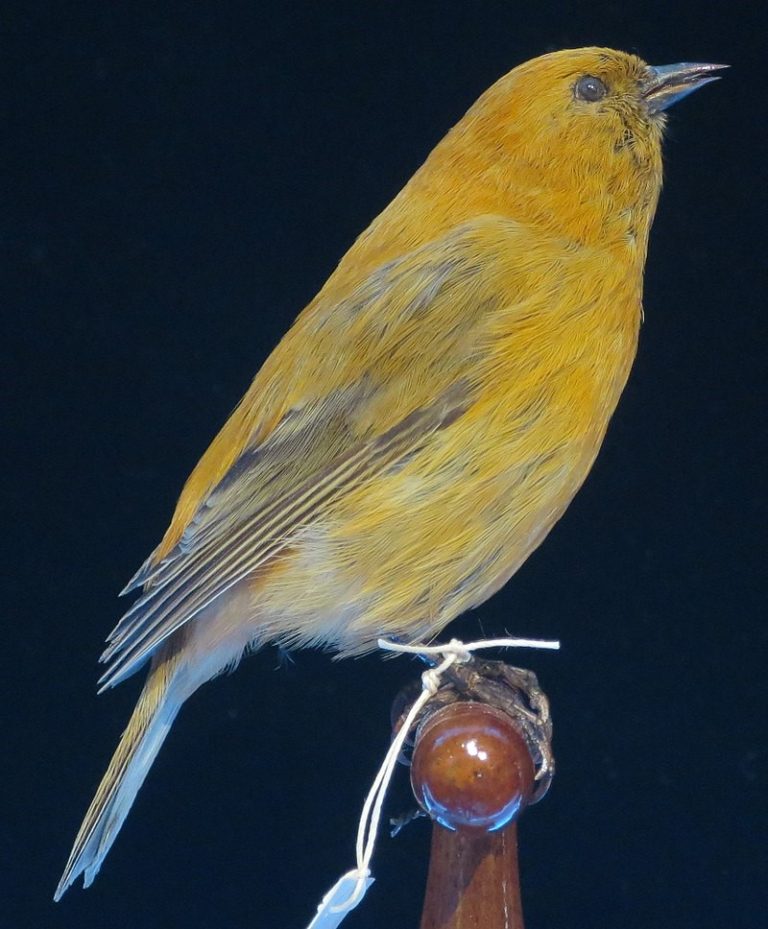
Maui Akepa, male. © Bernice Pauahi Bishop Museum
Formerly endemic to Maui.
A small honeycreeper with a short, thin bill. Similar to Hawaii Akepa but the bill was gray, the male plumage was pale-orange or yellowish, and the female was more olive. Traditionally considered conspecific with Maui and Hawaii Akepas, known collectively as the Akepa (Loxops coccineus).
Inhabited wet forests from the lowlands up to middle elevations. The last confirmed record was a set of specimens collected June 10-15, 1901, near Ukulele. It certainly survived for some years, and possibly many decades, after that, but documentation during the 1900s is sparse. The consensus of researchers seems to be that it survived in small numbers on the northern slopes of Mount Haleakala into the 1980s, and that the last persuasively described sight record occurred in 1988. Surveys in the 1990s yielded audio recordings that were possibly this species.